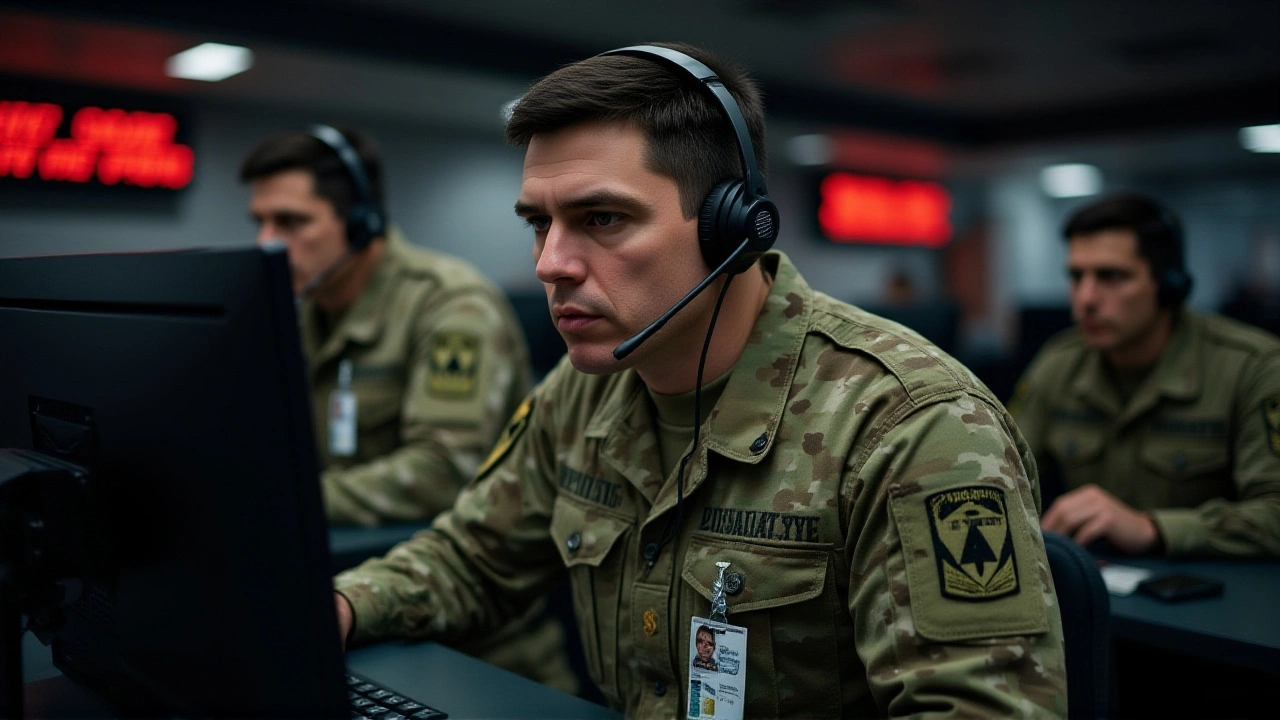When House of Dynamite debuted on Netflix on October 26, 2025, it didn’t just deliver a tense nuclear thriller—it left millions of viewers staring at a blank screen, wondering if Chicago had been incinerated or if the United States had averted catastrophe.
The film, directed by Kathryn Bigelow, follows an 18‑minute crisis from three separate angles: the White House Situation Room, USSTRATCOM at Offutt Air Force Base, and the President’s bunker beneath the White House. By the time the credits roll, the audience knows enough to feel the pressure, but the final decision remains stubbornly opaque.
Bigelow’s Vision and the Film’s Roots
Bigelow, the Oscar‑winning director of Zero Dark Thirty and The Hurt Locker, has long been fascinated by high‑stakes, real‑time storytelling. In a CBS Sunday Morning interview she likened civilization to a house packed with dynamite, asking, “How do we take the dynamite out of the walls without tearing down the house?” The metaphor drives the entire narrative, turning the United States’ nuclear arsenal—estimated at roughly 13,000 warheads—into a character in its own right.
Co‑writer Mark Boal, who earned an Academy Award for The Hurt Locker, explained to Netflix’s Tudum platform that the ambiguous ending was a conscious choice: “Any tidy resolution would let the audience off the hook. We wanted viewers to sit with the uncertainty that decision‑makers actually face.”
Plot Overview: Three Perspectives, One Crisis
First, we meet Rebecca Ferguson as Captain Olivia Walker, a steady‑hand officer in the Situation Room. As a missile arcs toward the continental United States, Walker makes a frantic call to her husband Ben (played by Neal Bledsoe), urging him to grab their son Liam and drive west—no explanation, just raw urgency.
Meanwhile, at Offutt Air Force Base in Omaha, Nebraska, Defense Secretary Jared Harris and a team of generals scramble countermeasures. One interceptor misfires, another misses entirely, and the system reports a “Negative to confirmed impact,” prompting the jump to DEFCON 1, the highest state of readiness.
The final act drops us into the Presidential Emergency Operations Center, a self‑sufficient bunker beneath the White House. Here, President Idris Elba receives two stark options from Lieutenant Commander Reeves (ah‑Kong): launch a retaliatory strike that could spark global nuclear war, or absorb the Chicago hit to protect the broader world. The camera never shows his decision, nor the missile’s impact on Chicago, and the screen cuts to black.
Ambiguous Ending: What It Means for Audiences
Bigelow told Tudum, “The antagonist is the system we built, a hair‑trigger that can end the world.” By refusing to reveal whether Chicago burns, she forces viewers to grapple with the same uncertainty that real‑world policymakers endure. The twist, as she put it, is meant to spark conversation: “I want audiences to leave thinking, ‘Okay, what do we do now?’”
Rebecca Ferguson echoed that sentiment, noting, “One individual holds the power to start a nuclear war. When that happens, the fallout is massive—not just for the target, but for humanity.” The film’s recurring visual of Liam’s toy meteorite, first seen in the opening scene, reinforces the idea that a single spark can ignite global extinction, much like the asteroid that ended the dinosaurs.
Critical Reception and Cultural Context
Critics were split. The New York Times praised the film’s “relentless tension” but lamented the lack of closure, calling it “a brilliant exercise in dread that sometimes feels like a rhetorical stunt.” Conversely, Variety highlighted the film’s relevance to current geopolitical tensions, noting that the United Nations reported a 12% rise in nuclear rhetoric among the major powers during 2024‑25.
Streaming numbers tell a different story: Netflix reported 18 million households started the film within its first week, and social‑media chatter spiked by 45% on the hashtag #HouseOfDynamite. Many viewers posted fan theories—some insisting the missile missed, others that the President chose retaliation—demonstrating exactly the conversation Bigelow hoped to ignite.

What the Film Says About Nuclear Policy
The narrative underscores three systemic flaws: fragmented communication, the absence of clear protocols for a domestic nuclear strike, and the concentration of decision‑making power in a single individual. Real‑world experts agree. Dr. Elena Ramirez, a senior fellow at the Brookings Institution, told the BBC that “the film dramatizes a scenario that, while unlikely, reveals how thin the procedural safeguards truly are.” She added that the U.S. nuclear command structure still relies heavily on human judgment under extreme pressure.
In practical terms, the film could reignite calls for modernizing the nuclear launch authority, a topic already debated in the Senate after a 2023 incident where a faulty alarm triggered a false‑positive alert. By weaving fiction with factual concerns, "House of Dynamite" serves as both art and policy prompt.
Future Outlook: Where Do We Go From Here?
Bigelow hinted that a companion documentary may be in the works, focusing on the behind‑the‑scenes development of the film’s crisis simulations. Meanwhile, Netflix has announced a limited‑time “Discussion Hub” where viewers can join live panels with security analysts and the film’s cast.
Whether or not Chicago was scorched, the real explosion—according to Bigelow—happens in the conversations that follow. As audiences continue to dissect the ending, the hope is that the debate will translate into tangible steps toward reducing the world’s nuclear stockpile, or at least making the “house” a little less volatile.
Frequently Asked Questions
How does the ambiguous ending affect viewers' perception of nuclear risk?
The lack of a definitive outcome forces viewers to imagine both catastrophic and survivable scenarios, mirroring the real uncertainty faced by policymakers. This psychological tension often leads to heightened awareness of how fragile deterrence can be, prompting many to research actual nuclear protocols after watching.
What real‑world events inspired the film's premise?
Bigelow cited the 2023 false alarm in Alaska, where a glitch signaled an incoming missile, and the ongoing tensions surrounding the Ukraine conflict as direct inspirations. Both incidents highlighted how close a technical error or miscommunication could bring the world to the brink.
Who are the primary creative forces behind the film?
The film was directed by Kathryn Bigelow and co‑written by Mark Boal. Their collaboration blends Bigelow’s visual tension with Boal’s experience in depicting military decision‑making.
What is the significance of the toy meteorite recurring in the film?
The meteorite toy symbolizes the ever‑present threat of sudden extinction, echoing the asteroid that ended the dinosaurs. Its presence reminds the audience that humanity’s self‑inflicted “meteor”—nuclear weapons—could have similarly catastrophic effects.
Will there be a sequel or related projects?
While Netflix has not confirmed a direct sequel, a behind‑the‑scenes documentary is reportedly in early development, focusing on the technical simulations and the policy experts consulted during production.




From the moment the screen fades in, the audience is thrust into a ticking clock that feels almost physiological.
The cinematography deliberately avoids wide shots, opting instead for cramped, claustrophobic frames that echo the pressure inside the Situation Room.
As Olivia Walker frantically calls her husband, the raw urgency is palpable, and the viewer can almost hear the beat of a frantic heart.
The film’s decision to cut away from the missile’s trajectory forces us to sit with an uncomfortable silence that mimics real‑world indecision.
This silence is not a flaw but a narrative device that mirrors the vacuum of information that policymakers often endure.
By presenting three distinct viewpoints, the story layers the complexity of command and control into an almost operatic structure.
The intercut between Offutt and the bunker is paced like a metronome, each cut reinforcing the sense that seconds matter more than minutes.
When the President is presented with the choice of retaliation, the camera’s lingering on his face becomes a study in moral calculus.
The absence of a visual resolution leaves the audience grappling with the same ethical ambiguity that the characters face.
In doing so, the film transcends simple thriller conventions and becomes a meditation on collective responsibility.
The recurring motif of the toy meteorite subtly reminds viewers that humanity’s self‑inflicted “asteroid” can be just as devastating.
Moreover, the script’s restraint in dialogue allows the silence to speak louder than any exposition could.
The way the sound design amplifies the hum of machinery and the occasional crackle of radio static adds to the immersive dread.
Critics who demand a tidy ending may overlook the intentional discomfort that encourages deeper reflection on nuclear policy.
Ultimately, the film succeeds because it does not seek to give answers, but rather to ignite a conversation that extends far beyond the theater.
In terms of cinematic craftsmanship, the production exhibits a disciplined adherence to realism, which serves to underscore the gravity of the scenario.
The deliberate omission of a conclusive climax compels the discerning viewer to engage in substantive discourse regarding deterrence doctrine.
Stakeholders across the strategic community may find this artistic choice a catalyst for policy examination.
It is commendable that the filmmakers have opted for nuance over sensationalism.
Such an approach aligns with the broader imperative of fostering informed public deliberation.
Whoa, the tension in that bunker scene gave me heart‑racing vibes! 😱
Those quick cuts had my pulse syncing with the on‑screen alarms, almost like I was in a live drill.
And that toy meteorite? Total metaphor gold! 🌟
Can’t wait to see what the discussion hub brings – maybe we’ll finally settle the Chicago debate! 🙌
Totally get the formal vibe – the film really pushes us to think deeper 🤔
Ah, the classic “let‑the‑audience‑suffer‑in‑silence” trick – because nothing says “thought‑provoking” like denying us any closure.
It’s almost as if the filmmakers think we’ll spend our free time Googling nuclear protocols instead of actually enjoying a story.
Sure, ambiguity can be artistic, but here it feels more like a lazy excuse for a weak script.
Still, credit where it’s due: the tension is genuine, and the sound design does an excellent job of making you hear the panic.
Just wish the narrative didn’t rely so heavily on us to fill the gaps.
Big kudos to the crew for keeping the adrenaline high from start to finish!
The pacing never lets you catch your breath, which is exactly how a real‑time crisis should feel.
Hope the buzz continues in the discussion panels.